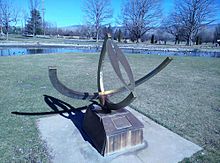
Back Sonwyser Afrikaans Sonnenuhr ALS مزولة Arabic Reló de sol AST Günəş saatı Azerbaijani گونش ساعاتی AZB Ҡояш сәғәте Bashkir Сонечны гадзіннік Byelorussian Сонечны гадзіньнік BE-X-OLD Слънчев часовник Bulgarian



A sundial is a horological device that tells the time of day (referred to as civil time in modern usage) when direct sunlight shines by the apparent position of the Sun in the sky. In the narrowest sense of the word, it consists of a flat plate (the dial) and a gnomon, which casts a shadow onto the dial. As the Sun appears to move through the sky, the shadow aligns with different hour-lines, which are marked on the dial to indicate the time of day. The style is the time-telling edge of the gnomon, though a single point or nodus may be used. The gnomon casts a broad shadow; the shadow of the style shows the time. The gnomon may be a rod, wire, or elaborately decorated metal casting. The style must be parallel to the axis of the Earth's rotation for the sundial to be accurate throughout the year. The style's angle from horizontal is equal to the sundial's geographical latitude.
The term sundial can refer to any device that uses the Sun's altitude or azimuth (or both) to show the time. Sundials are valued as decorative objects, metaphors, and objects of intrigue and mathematical study.
The passing of time can be observed by placing a stick in the sand or a nail in a board and placing markers at the edge of a shadow or outlining a shadow at intervals. It is common for inexpensive, mass-produced decorative sundials to have incorrectly aligned gnomons, shadow lengths, and hour-lines, which cannot be adjusted to tell correct time.[2]
- ^ "Flagstaff Gardens, Victorian Heritage Register (VHR) Number H2041, Heritage Overlay HO793". Victorian Heritage Database. Heritage Victoria. Retrieved 2010-09-16.
- ^ Moss, Tony. "How do sundials work". British Sundial society. Archived from the original on August 2, 2013. Retrieved 21 September 2013.
This ugly plastic 'non-dial' does nothing at all except display the 'designer's ignorance and persuade the general public that 'real' sundials don't work.
© MMXXIII Rich X Search. We shall prevail. All rights reserved. Rich X Search